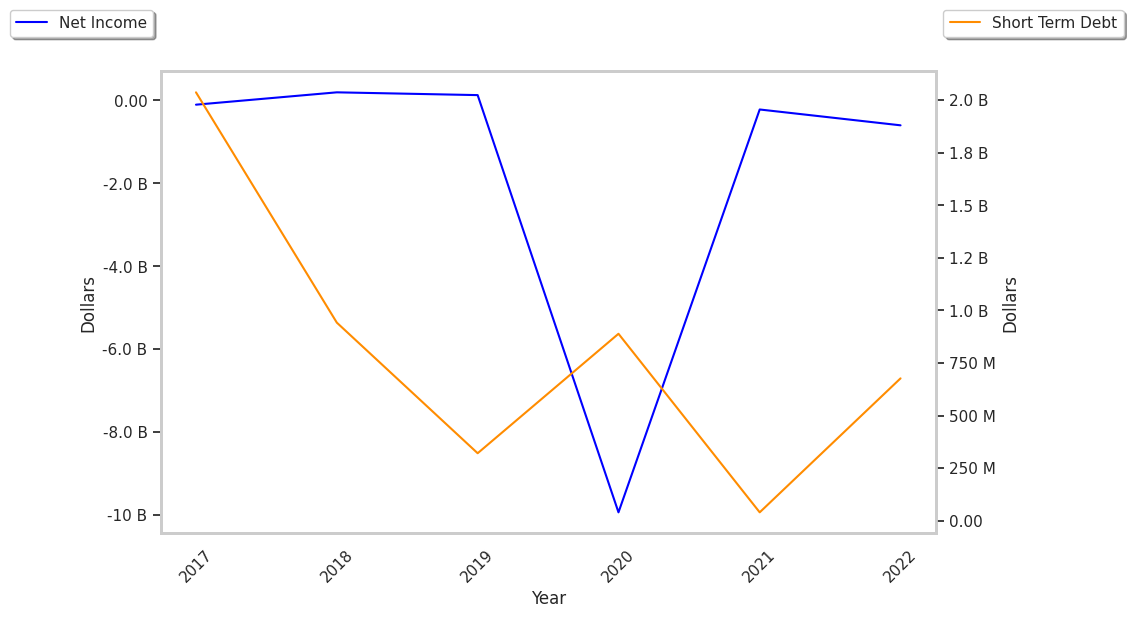Now trading at a price of $41.76, Baker Hughes has moved -1.8% so far today.
Baker Hughes returned gains of 31.9% last year, with its stock price reaching a high of $45.17 and a low of $28.32. Over the same period, the stock returned a similar cumulative performance to the S&P 500. The company's 50-day average price was $39.79.
Baker Hughes Company provides a portfolio of technologies and services to energy and industrial value chain worldwide. Based in Houston, TX, the Large-Cap Industrials company has 57,000 full time employees. Baker Hughes has offered a 2.0% dividend yield over the last 12 months.
Generally Positive Cash Flows but an Average Current Ratio:
| 2018 | 2019 | 2020 | 2021 | 2022 | 2023 | |
|---|---|---|---|---|---|---|
| Revenue (M) | $22,877 | $23,838 | $20,705 | $20,502 | $21,156 | $25,506 |
| Operating Margins | 3% | 5% | -77% | 6% | 6% | 9% |
| Net Margins | 1% | 1% | -48% | -1% | -3% | 8% |
| Net Income (M) | $195 | $128 | -$9,940 | -$219 | -$601 | $1,943 |
| Net Interest Expense (M) | -$223 | -$237 | -$264 | -$299 | -$252 | -$216 |
| Depreciation & Amort. (M) | $1,486 | $1,418 | $1,317 | $1,105 | $1,061 | $1,087 |
| Diluted Shares (M) | 1,130 | 1,036 | 6,550 | 8,060 | 1,027 | 1,011 |
| Earnings Per Share | $0.45 | $0.23 | -$14.73 | -$0.27 | -$0.61 | $1.91 |
| Avg. Price | $26.38 | $21.04 | $15.13 | $22.03 | $30.95 | $41.94 |
| P/E Ratio | 57.35 | 91.48 | -1.03 | -81.59 | -50.74 | 21.73 |
| Free Cash Flow (M) | $767 | $886 | $330 | $1,518 | $899 | $1,838 |
| CAPEX (M) | $995 | $1,240 | $974 | $856 | $989 | $1,224 |
| EV / EBITDA | 15.23 | 10.1 | -1.3 | 10.68 | 16.01 | 13.45 |
| Total Debt (M) | $7,227 | $6,622 | $7,633 | $6,727 | $6,657 | $6,020 |
| Net Debt / EBITDA | 1.6 | 1.35 | -0.24 | 1.19 | 1.86 | 0.99 |
| Current Ratio | 1.66 | 1.52 | 1.61 | 1.65 | 1.32 | 1.25 |
Baker Hughes has slight revenue growth and a flat capital expenditure trend, weak operating margins with a positive growth rate, and just enough current assets to cover current liabilities, as shown by its current ratio of 1.25. We also note that the company benefits from generally positive cash flows and healthy leverage levels. Furthermore, Baker Hughes's financial statements do not display any obvious red flags.
a Lower P/B Ratio Than Its Sector Average but Priced Beyond Its Margin of Safety:
Baker Hughes has a trailing twelve month P/E ratio of 17.8, compared to an average of 25.42 for the Industrials sector. Based on its EPS guidance of $2.57, the company has a forward P/E ratio of 15.5. According to the 28.3% compound average growth rate of Baker Hughes's historical and projected earnings per share, the company's PEG ratio is 0.63. Taking the weighted average of the company's EPS CAGR and the broader market's 5-year projected EPS growth rate, we obtain a normalized growth rate of 16.3%. On this basis, the company's PEG ratio is 1.1. This implies that the shares are fairly valued. Additionally, the market is possibly undervaluing Baker Hughes in terms of its equity because its P/B ratio is 2.55 whereas the sector average is 3.2. The company's shares are currently trading 63.4% below their Graham number.
There's an Analyst Consensus of Some Upside Potential for Baker Hughes:
The 25 analysts following Baker Hughes have set target prices ranging from $34.0 to $53.0 per share, for an average of $44.62 with a buy rating. The company is trading -6.4% away from its average target price, indicating that there is an analyst consensus of some upside potential.
Baker Hughes has an average amount of shares sold short because 2.1% of the company's shares are sold short. Institutions own 98.2% of the company's shares, and the insider ownership rate stands at 0.12%, suggesting a small amount of insider investors. The largest shareholder is Vanguard Group Inc, whose 15% stake in the company is worth $5,075,546,193.



